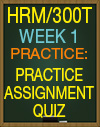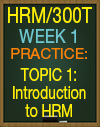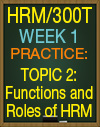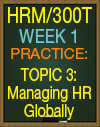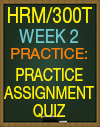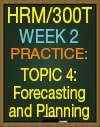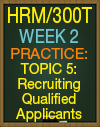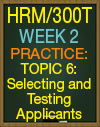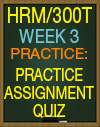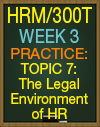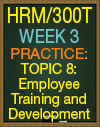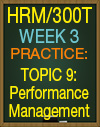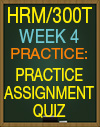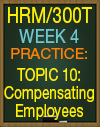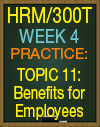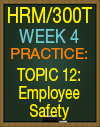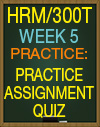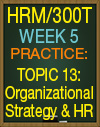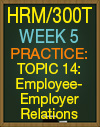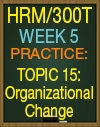HRM/300T Fundamentals of Human Resource Management |
|
|
|
|
|
|
|
|
HRM/300T Fundamentals of Human Resource Management
Week 1 Kit Includes All Tutorials listed below:
- Apply Quiz (includes Quiz#1 and Quiz#2)
- Practice Quiz (includes 2 Quizzes)
- Topic 1 Quick Check - Introduction to HRM
- Topic 2 Quick Check - Functions and Roles of HRM
- Topic 3 Quick Check - Managing HR Globally
Apply Assignment Quiz#1 (included)
- Caitlyn has worked in HR for Clearwater Electronics for more than 20 years. She has found that many employees are now more concerned with working in an environment where they can grow personally than with their level of compensation. How can Caitlyn and the HR department best provide opportunities for their employees to grow?
- As the HR director of Clearwater Electronics, you know it is important for HR to be as close as possible to where the people and problems are located. Which reason best explains why it is important for HR to know the line managers and their needs?
- The results of unethical behavior in a business can be catastrophic, both financially and in reputation. Clearwater Electronics currently has a solid reputation as an ethical organization and wants to maintain that reputation. Top management has tasked the HR department to reinforce ethical behavior consistently throughout the company. Given that responsibility, why is it especially important for the HR professionals themselves to behave ethically?
- You are the HR director for Clearwater Electronics and have been invited to the organization’s yearly strategic goal-setting meeting. You started with the company six months ago, so this is the first time you have been invited to attend. Why do you think it important you attend this meeting, and how do you think HR can best contribute to the organization?
- Clearwater Electronics has an employee recruitment and retention goal of 90 percent. How does HR planning best help the company meet or exceed its employee recruitment and retention goal?
- Clearwater Electronics wants to strategically attract new talent to the organization to support future growth. Why is it important for the HR director to work with top management to improve the firm’s recruiting system?
- A line manager at Clearwater Electronics has just hired a female employee who is pregnant. Her baby is due at the same time production peaks, which is extremely inconvenient for the line manager, who is responsible for production numbers. The line manager did not know the employee was pregnant when he hired her. He has now hinted to the employee that her pregnancy will make it harder for her to do her job in the hope that with enough hints, the employee will decide to quit or transfer to another position. Clearwater Electronics has a strong policy to prevent and address employment discrimination. Why should the HR director become involved in this situation instead of leaving it up to the line manager to handle?
- The HR recruiting specialist and line managers at Clearwater Electronics work closely together when hiring new employees. The line managers are ultimately responsible for the final selection of a new employee, but the HR recruiting specialist serves an important role by providing information about potential employees and arranging for interviews. Why is this service helpful to the line managers?
- Clearwater Electronics has installed several new machines that will improve line productivity. The training and development specialist at Clearwater Electronics is working with the line managers who are responsible for the new machines to develop a training program for line workers. Why is a training program needed in this situation, and how can it best help the employees?
- At Clearwater Electronics, the HR department is revamping the compensation function of the company in order to attract and retain qualified employees who are more likely to contribute to the company’s strategic goals and objectives. Why is it important for the company to be concerned about more than just wages and salaries?
- Clearwater Electronics is having a hard time matching its demand for staffing needs. The COO has asked the HR director to develop a forecast to project temporary labor versus full-time employees. Why is this type of analysis helpful for human resource planning (HRP)?
- The HR director at Clearwater Electronics has been asked to work on the company’s globalization process. Management has specifically asked that all managers in the company subsidiaries come from the corporate office, and the HR director is developing a job description template with a list of competencies needed for these managers to be successful. In addition, she is developing a survey to assess family interest and needs. What is the best reason for the family survey to be included in any future job posting where a manager might take their family abroad?
- The HR director at Clearwater Electronics has had negative feedback from employees about perceived inequalities in compensation among its company subsidiaries. While the HR director believes compensation is already consistent and fair, a review of the compensation and benefits packages will be conducted and shared with the employees. Which of the following statements gives the best reason for conducting and sharing the compensation assessment?
- Clearwater Electronics just hired a new warehouse manager in India. He has several employees who report to him. The HR director will be training the warehouse manager to conduct quarterly performance appraisals and has sent him the performance appraisal form she uses for her own direct reports as a template. However, she has asked him to modify it to better assess the needs of the Indian subsidiary. Why is it important that the warehouse manager make the modifications?
- The HR department at Clearwater Electronics has been asked to develop a job description for a new managerial position in Dubai. Clearwater’s policy states that subsidiary managers should be employees from the parent company. What benefits does the company hope to realize from this ethnocentric approach?
- The scarcity of qualified HR managers with global experience has been identified as a major challenge for the HR department at Clearwater Electronics. Therefore, the HR director has developed a job rotation program where selected, highly skilled HR managers will work abroad in one or more assignments during their career. Why is it most important for these HR managers to increase their appreciation of cross-cultural differences, develop a global perspective, strengthen their technical skills, and broaden their socioeconomic and political knowledge?
- Due to an increasing number of company employees, the HR department at Clearwater Electronics wants to implement a new human resource information system (HRIS). The department plans to hire a new employee to assist in this implementation and will be looking for someone with technical skills in HRIS as well as communication skills. why is it important for HR professionals now to have these skills?
- Clearwater Electronics, which has approximately 1,600 employees, is hiring a compensation and benefits manager. This HR specialist position will work with the highest levels of the company’s management team to ensure the costs of compensation and benefits align with the company’s strategy and philosophy. Why is this position a crucial one for the HR department?
- Productivity is an important goal for Clearwater Electronics. Like most productive organizations, Clearwater recognizes the contributions human resource management (HRM) can make to improve productivity through people. How can HRM best ensure that the work environment at Clearwater is one in which employees are productive and add value?
- Susan Lopez, the CEO of Clearwater Electronics, has recently provided details of a large change initiative that is forecasted to begin next year. As part of the briefing, Susan explained that previous company-wide changes were rough, that both time and money were wasted, and that employee morale suffered. If the previous organizational change was so painful, why would the CEO feel it important to implement another change initiative, and how can HR best support the CEO in this initiative?
- As the HR director of Clearwater Electronics, you are the direct supervisor for several employees within your department. As their direct supervisor, you are tasked with conducting individual performance appraisals and providing feedback on their performance. Why should you and your direct reports take this activity seriously?
- Clearwater Electronics plans to open a company subsidiary in Dubai, United Arab Emirates. The new office will have several engineering positions to fill and has asked for assistance from the HR Director. The HR director has recommended some of these positions be filled by current engineers from Clearwater's Bengaluru, India, office. What is the best reason for the HR director to make this recommendation to have third-country nationals relocate to Dubai?
- The HR department at Clearwater Electronics requires all HR professionals in their main office in the United States to be well-informed about global HR issues and processes. Which statement best explains why it is important for HR professionals who never plan to work abroad in one of the company subsidiaries to be well-informed about global HR?
Apply Assignment Quiz#2 (included)
- The results of unethical behavior in a business can be catastrophic, both financially and in reputation. Clearwater Electronics currently has a solid reputation as an ethical organization and wants to maintain that reputation. Top management has tasked the HR department to reinforce ethical behavior consistently throughout the company. Given that responsibility, why is it especially important for the HR professionals themselves to behave ethically?
- Clearwater Electronics now has 1,600 employees and an HR department with several employees. However, it was not always that large. In its second year, the company was growing steadily and hired its 40th employee. At that time, the CEO decided to hire an HR generalist to manage all human resources functions. Why was this decision the best thing for the company at the time?
- Clearwater Electronics wants to strategically attract new talent to the organization to support future growth. Why is it important for the HR director to work with top management to improve the firm’s recruiting system?
- You are the HR director for Clearwater Electronics and have been invited to the organization’s yearly strategic goal-setting meeting. You started with the company six months ago, so this is the first time you have been invited to attend. Why do you think it important you attend this meeting, and how do you think HR can best contribute to the organization?
- Productivity is an important goal for Clearwater Electronics. Like most productive organizations, Clearwater recognizes the contributions human resource management (HRM) can make to improve productivity through people. How can HRM best ensure that the work environment at Clearwater is one in which employees are productive and add value?
- As the HR director of Clearwater Electronics, you know it is important for HR to be as close as possible to where the people and problems are located. Which reason best explains why it is important for HR to know the line managers and their needs?
- Clearwater Electronics has installed several new machines that will improve line productivity. The training and development specialist at Clearwater Electronics is working with the line managers who are responsible for the new machines to develop a training program for line workers. Why is a training program needed in this situation, and how can it best help the employees?
- Susan Lopez, the CEO of Clearwater Electronics, has recently provided details of a large change initiative that is forecasted to begin next year. As part of the briefing, Susan explained that previous company-wide changes were rough, that both time and money were wasted, and that employee morale suffered. If the previous organizational change was so painful, why would the CEO feel it important to implement another change initiative, and how can HR best support the CEO in this initiative?
- An employee on one of Clearwater Electronics’ production lines violated safety protocols by disabling a machine’s safety guard. The line manager wrote up the employee and submitted the violation to HR. Why is it important for managers and HR to work together to promote a safety-first culture?
- At Clearwater Electronics, the HR department is revamping the compensation function of the company in order to attract and retain qualified employees who are more likely to contribute to the company’s strategic goals and objectives. Why is it important for the company to be concerned about more than just wages and salaries?
- As the HR director of Clearwater Electronics, you are the direct supervisor for several employees within your department. As their direct supervisor, you are tasked with conducting individual performance appraisals and providing feedback on their performance. Why should you and your direct reports take this activity seriously?
- The HR department at Clearwater Electronics has been asked to develop a job description for a new managerial position in Dubai. Clearwater’s policy states that subsidiary managers should be employees from the parent company. What benefits does the company hope to realize from this ethnocentric approach?
- Clearwater Electronics plans to open a company subsidiary in Dubai, United Arab Emirates. The new office will have several engineering positions to fill and has asked for assistance from the HR Director. The HR director has recommended some of these positions be filled by current engineers from Clearwater’s Bengaluru, India, office. What is the best reason for the HR director to make this recommendation to have third-country nationals relocate to Dubai?
- Clearwater Electronics just hired a new warehouse manager in India. He has several employees who report to him. The HR director will be training the warehouse manager to conduct quarterly performance appraisals and has sent him the performance appraisal form she uses for her own direct reports as a template. However, she has asked him to modify it to better assess the needs of the Indian subsidiary. Why is it important that the warehouse manager make the modifications?
- The HR department at Clearwater Electronics requires all HR professionals in their main office in the United States to be well-informed about global HR issues and processes. Which statement best explains why it is important for HR professionals who never plan to work abroad in one of the company subsidiaries to be well-informed about global HR?
Practice Assignment (includes 2 Quizzes with Answers)
- HR tactics can help organizations in many ways. Which of the following is not something HR helps with?
- What is the goal of the selection process when trying to staff an organization’s needs?
- Performance appraisals are important for both measuring and monitoring an employee’s contribution, but they are also often the basis for deciding what?
- In the changing world, what term is now being used to describe the traditional work environment?
- Many employees are taking a more active role in managing their own careers. However, what is something the HR department must do rather than individual employees?
- What is one thing millennials entering the workforce are concerned about?
- Top management has a great influence on the HR manager and the department. How does top management influence the HR department the most?
- Which of the following laws provides the most comprehensive protection against discrimination in the hiring process?
- Which of the following is defined as “a process that helps individuals within an organization understand what needs to be achieved, and then motivates and trains individuals to accomplish those needs?”
- Which of the following is an example of an employee benefit?
- Which of the following is considered an HR planning activity?
- Which of the following roles of HR managers involves designing an intervention to better align an organization with its goals, then implementing and evaluating the intervention?
- Predicting the human resource needs of an organization is commonly known as ____________.
- Labor unions constrain multinational corporations’ choices in three ways. Which of the following is not one of these ways?
- Which of the following is not something that international HR executives will have to develop to be successful in IHR?
- Which of the following job titles is usually one of the last that companies send abroad?
- Which of the following are true of international compensation packages? (Select all that apply.)
- What is the most common reason that expatriates return early from international assignments?
- Which of the following comes last in establishing a corporation internationally?
- Which of the following features or constraints does not need to be considered when completing the performance appraisals for managers of multinational corporations?
Practice: Topic 1 Quick Check - Introduction to HRM
- Which of the following is not a way HR professionals can create an ethical organizational culture?
- What is one way that HR can improve the quality of life for most employees in today’s world?
- Which ability is not needed to have great analytical skills?
- The effectiveness of an organization’s HR management function depends largely upon ________.
- Which of the following is not necessary for HR specialists to do their job well?
- What is one of the two categories of HR professionals?
- Performance appraisals are important for both measuring and monitoring an employee’s contribution, but they are also often the basis for deciding what?
- Although employees are starting to take a more active role in managing their own careers, the HR department still plays a significant role. What is that role?
- Many employees are taking a more active role in managing their own careers. However, what is something these employees cannot do?
- Which of the following is not a function of human resource management?
Practice: Topic 2 Quick Check - Functions and Roles of HRM
- What is the line managers’ role in the selection and orientation process?
- Alcoholism is considered which type of health and safety condition?
- What is the supreme law of the land in the United States?
- Which of the following is the correct definition of a union?
- Which of the following types of compensation includes wages, benefits, and training?
- What is the purpose of the compensation function of HR?
- Which of the following is not true concerning HR planning?
- What is another name for fringe benefits?
- Training and development are used to do all of the following except ________.
- Who makes the final decision as to whether a law complies with the provisions of the U.S. Constitution?
Practice: Topic 3 Quick Check - Managing HR Globally
- All of the following are competencies that HR professionals should look for in potential international employees except _________.
- Which of the following is not an important aspect of completing the performance appraisal of a manager in a multinational corporation?
- What is the first step when it comes to a company establishing itself internationally?
- Which of the HR strategies for expanding an organization into the global arena is usually the most cost-effective way to get human capital?
- Which of the following is not an objective of compensating employees?
- What is the first and most frequent international HR concern?
- At which stage of international development are many of the needs met by outside groups or personnel?
- What is the definition of an expatriate?
- Labor unions constrain multinational corporations in all of the following ways except by _________.
- What is the term for an employee who works for an international company and is assigned back to work in his or her home country?
|
|
|
|
|
|
|
|
HRM/300T Fundamentals of Human Resource Management
Week 2
Week 2 Kit Includes:
Apply: Week 2 Apply Assignment
Practice: Week 2 Practice Assignment
Practice: Topic 4 Quick Check - Forecasting and Planning
Practice: Topic 5 Quick Check - Recruiting Qualified Applicants
Practice: Topic 6 Quick Check - Selecting and Testing Applicants
Apply: Week 2 Apply Assignment (includes 1st and 2nd Attempt Quizzes)
Apply Quiz#1
- Why is HRP one of the fastest growing and most important areas of human resource management?
- Which of the following is a characteristic of the traditional organizational model rather than the new organizational model?
- Which of the following is a strategy to forecast supply but not demand?
- Why is it important to know what an organization’s learning curve is when forecasting demand?
- Which of the following is true of human resource planning?
- What can help an organization decrease the need for initial employee training?
- Which of the following recruitment methods often result in an oversupply of qualified employees?
- Two tangible products of job analysis are __________.
- Which of the following is true of the recruitment process?
- Which of the following is an external source of recruiting?
- What is a reference point in the selection process?
- How do performance appraisals affect the selection process?
- Which of the following uses the correlation coefficient as a measure of validity?
- What is test-retest reliability?
- Which of the following is true of selecting and testing applicants?
Apply Quiz#2
- Which of the following is true of forecasting in HR?
- Which of the following is one of the major challenges faced when implementing a human resource plan?
- Why is it important to know what an organization’s learning curve is when forecasting demand?
- Why is HRP one of the fastest growing and most important areas of human resource management?
- Which of the following is a characteristic of the traditional organizational model rather than the new organizational model?
- What is an advantage of using an internal job posting for a job opening?
- Which of the following is an external source of recruiting?
- Which of the following is the purpose of strategic business planning?
- Which of the following is true of the recruitment process?
- What can help an organization decrease the need for initial employee training?
- What is the first step for improving the selection decision?
- Which of the following actions, if taken by HR, would increase the likelihood of having lawsuits brought against the organization?
- What is test-retest reliability?
- What is a reference point in the selection process?
- How do performance appraisals affect the selection process?
- What can a company do to make sure it is using the best recruiting method?
- Which of the following actions would decrease the validity of a reference check?
- Which of the following is true of selecting and testing applicants?
Practice: Week 2 Practice Assignment
- Which term describes the type and number of competitors’ job openings when looking at supply and demand within HR?
- Which of the following types of HR policies would detract from an organization’s overall goals if the organization wants to adopt an entrepreneurial strategy?
- Which of the following is true of human resource planning?
- Values related to work are changing, which means that HR planning activities also need to change. Which of the following is something that the majority of today’s workers are not valuing more?
- There are six purposes of human resource planning. Which of the following is not one of those purposes?
- What is the third stage in HR planning?
- Criteria for evaluating HR planning need to balance forecasted versus actual data. Which of the following is a criterion that could be used to evaluate HR planning?
- Which of the following is a disadvantage of an internal job posting?
- The two major components of job-matching systems are _________.
- Which of the following is an external recruitment method?
- When is a good time to begin recruiting with colleges?
- Which of the following is not one of the purposes of recruitment?
- Which of the following is the main purpose of HR planning when it comes to recruiting programs?
- What is not a major purpose of orientation and socialization?
- Which of the following are parameters that must be considered when applying the selection process? (Select all that apply.)
- Organizations should make selection decisions based on all available information except ________.
- What does an effective selection process not do for an organization?
- What is reliability?
- Effective orientation and socialization of employees enhances the effectiveness of an organization’s selection decisions by doing what?
- Demonstrating that a relationship exists between a selection procedure and a psychological trait or measure is the definition of which measure of validity?
- Ensuring the right people are in the right jobs at the right time to meet the needs of an organization is usually the responsibility of an ____________.
- Which of the following is a disadvantage of using the employee referral program as an internal resource for hiring?
- Which of the following is not a role that line managers play in the selection and orientation process?
Practice: Topic 4 Quick Check - Forecasting and Planning
- What is the next step in human resource planning once the business plans are determined?
- Which of the following is not a question that HR professionals need to ask of internal managers when starting to forecast an organization’s human resource needs?
- Which of the following is not true of human resource planning?
- What is a judgmental technique used by organizations to make supply forecasts?
- Which of the following is not one of the purposes of HR forecasting and planning?
- Which of the following is a characteristic of traditional organizations?
- What is the final phase in human resource planning?
- What is redundancy planning?
- What type of HR policy would not enhance a rationalization/maximize-the-profit strategy?
- Values relating to work are changing. Which of the following is not a change in values that has occurred?
Practice: Topic 5 Quick Check - Recruiting Qualified Applicants
- There are many advantages that some skilled and semiskilled individuals find with using temporary agencies. Which of the following is not an advantage of temporary agencies?
- How can an organization determine which recruiting method is most effective?
- What does an internal job posting not provide for an organization?
- What process is used to identify the necessary KSAs and individual preferences for each job within an organization?
- What types of job applicants do private employment agencies tend not to serve?
- Which recruitment document indicates what kind of people a business seeks?
- What is a disadvantage of engaging in mergers and acquisitions?
- Which of the following is not true of recruitment?
- A job profile is one of the two major components in job-matching systems. What does a job profile contain?
- A statement of job responsibilities, tasks, and working conditions is called ________.
Practice: Topic 6 Quick Check - Selecting and Testing Applicants
- Which of the following actions, if taken by HR, would increase the likelihood of having lawsuits brought against the organization?
- What is not needed to begin the selection process?
- What is the simplest test of the reliability of a measuring device?
- There are three parameters that help give clear and precise information that is useful in the selection process. Which of the following is not one of those parameters?
- There are multiple reasons why it is important to lay out exact criteria and their relative importance. Which of the following is not one of those reasons?
- When deciding not to hire an employee for a job because of information found on a background check, the employer should do all of the following except ________.
- Organizations should make selection decisions based on all available information except ________.
- What does validity mean?
- What is internal consistency reliability?
- What is the professionally accepted standard for the stability coefficient?
|
|
|
|
|
|
|
|
HRM/300T Fundamentals of Human Resource Management
Week 3
Week 3 Kit Includes:
Apply: Week 3 Apply Assignment
Practice: Week 3 Practice Assignment
Practice: Topic 7 Quick Check - The Legal Environment of HR
Practice: Topic 8 Quick Check - Employee Training and Development
Practice: Topic 9 Quick Check - Performance Management
Apply: Week 3 Apply Assignment
- Due to a strong economy, the demand for electronic circuits has recently increased by 30 percent. Clearwater Electronics’ current employee count does not have the ability to meet this demand. In looking at the assembly process, it appears that the assembly group, the last group in the assembly line, needs more employee resources to assemble the circuits. To remedy this situation, the HR director begins to focus on both temporary hiring and full-time recruitment efforts for the assembly department. In due time, the assembly department has the employee resources it needs, but now the manufacturing operation that supplies the parts to the assembly department does not have enough skilled workers to keep up. How can HR planning best help ensure the organization’s staffing needs are being met?
- Clearwater Electronics is revising its strategic HR plan and comparing employment needs to the level of sales. The company has recently seen a 30 percent increase in sales, and the salespeople say that they anticipate an increase soon of 70 percent. However, the HR director, who oversees the HR planning process, does not believe the company will need to hire 70 percent more employees to meet the projected sales numbers. How can a simple linear regression, as part of the HR planning process, help the HR director make a more accurate determination of projected staffing needs?
- The HR department at Clearwater Electronics has received several complaints from new employees who say their job descriptions do not match what they are doing. They say they feel misled, and some of them have indicated they are thinking of quitting. The HR department is currently conducting a review of the job descriptions, in conjunction with the line managers. How can HR professionals best help to avoid a situation like this?
- Ashlyn works as an HR recruitment director for Clearwater Electronics, which is merging with another company, Laramie Peak Electric. The companies anticipate there will be excess employees as a result of the merger, creating a large pool of highly qualified individuals. With this in mind, Ashlyn and her team should do which of the following as they work to fill positions in the new organization?
- Over the last two years, Clearwater Electronics has been unable to recruit sufficient new talent to the organization. In the past, the HR recruiters have concentrated on external sources such as websites, employment agencies, newspaper ads, and educational institutions for their recruitment efforts. However, three months ago, the recruiters added an Employee Referral Program (ERP)—where current employees refer people they know for positions—to their recruiting activities and have seen an increase of potentially qualified applicants. Which reason best explains why this low-cost-per-hire method has produced results for the company?
- The IT department at Clearwater Electronics hired several new employees in new positions in the past four months. The IT department has asked HR to help craft a performance appraisal that the IT managers can use to demonstrate that the selection tools used for hiring predict performance success. Which statement gives the best reason for why it is important that criteria on a performance appraisal be related to the job?
- The HR department at Clearwater Electronics administers different tests to candidates for managerial positions to identify people with the traits and skills managers need to be successful leaders. The tests are meant to measure the leadership qualities of competence, work ethic, and emotional intelligence. Which of the following statements best explains why is it important for tests measuring these competencies to be valid?
- For a quarterly review of the HR department, the HR director at Clearwater Electronics must demonstrate the consistency of a skills test administered to new employees. The HR director plans on using the split-half reliability method—where questions are split in half and two scores are computed for each person—to determine the internal consistency of the skills test. Why is using this method a good idea?
- After an interview for a marketing position at Clearwater Electronics, one of the interviewers expressed concern that the applicant, who was in a wheelchair, would not fit into the department’s informal workplace health culture, which encourages playing basketball or pickleball together during lunch as well as going for walks or runs. The candidate is as well qualified as the other candidates and has more pertinent work experience. Should the interviewer’s concern be considered in whether to hire this individual?
- The maintenance department manager at Clearwater Electronics reported that one of his best employees has told everyone he is gay. Three other employees, who have worked with this individual for four years, contacted the manager and said they were now uncomfortable working alongside this person and want him to be transferred or else they will request to be transferred. The manager is supportive of his gay employee and does not want to transfer him. However, he also feels he cannot lose three other employees. Clearwater has formal LGBTQ awareness training in place as well as inclusive management training. How can the HR director best help the manager and the company prevent discriminatory conduct in the maintenance department?
- One of the engineers at Clearwater Electronics is a devout Muslim and is required to attend prayer services at his mosque during the day on Friday for a short period. He has asked his direct supervisor in the past if he might take time off, but his supervisor said it would be too inconvenient. The engineer has now asked HR for help in determining if a reasonable accommodation could be made so he can attend the midday prayer service. Which of the following statements would be considered the best “reasonable accommodation” HR can present to the supervisor?
- Clearwater Electronics’ sales are increasing rapidly, with a 30 percent increase currently and a projected 70 percent anticipated increase in the near future. In collaboration with production managers, the HR department discussed how best to manage the increased production needs with a minimum number of new hires. It was decided that employees from different departments should be cross-trained to enable them to move from area to area as needed, and a cross-training program is being developed. Which statement best explains why this plan is good for both employees and the company?
- The HR director at Clearwater Electronics has been tasked with leading a performance review of all supervisors in the company. The board specifically wants the HR director to deliver a direct comparison between supervisors across departments to determine whether company-wide goals are being met. The HR director has elected to use a conventional rating method, which is the most common form of performance evaluation. Why would this method be preferred over others?
- The director of the quality engineering department at Clearwater Electronics has been on the job for three months. One of her responsibilities is to review and approve the performance appraisals conducted by the department managers. The director does not agree with a performance appraisal that Matt, a manager, just submitted for one of his team engineers, whom he rated highly. The director has requested to see the performance appraisals Matt submitted previously for this employee to understand why Matt’s evaluation is so high when she has not seen performance that warrants the high rating. She discovered that a year ago, the employee’s son died in a tragic accident. The employee missed only three days of work afterward. Matt, very impressed by the employee’s devotion to the company, gave the employee high PA ratings even though the work performed was not excellent and continues to give the employee high ratings. Which statement below best explains the rating error the director found in Matt’s performance appraisal of the engineer?
- Clearwater Electronics recently received a complaint via its employee hotline from a terminated employee claiming he was fired because he was disliked by his supervisor, whom he said had harassed him. The HR department handles all harassment claims, and an investigation was immediately opened. One of the first steps the HR director took was to review the former employee’s quarterly performance appraisals, which had been signed by both the supervisor and the employee. Over the course of a year, the performance appraisals documented the following: the employee was often absent, had consistently produced poor quality work, and was insubordinate to his supervisor on several occasions. The HR director closed the case after determining the supervisor had appropriately terminated the employee with good cause. Using this case as an example, why is it especially important for performance appraisals to have detailed information on an employee’s performance?
Practice: Week 3 Practice Assignment (1st Attempt)
- Workers of what age are now protected by the ADEA?
- When was the EEOC (which is the agency created by the Civil Rights Act of 1964) given authority to enforce the laws of the Civil Rights Act of 1964?
- Which of the following is legal under Title VII of the Civil Rights Act of 1964?
- Affirmative action is defined as _________.
- Which of the following is not an element in an organization’s affirmative action plan?
- What was the Civil Rights Act of 1964 law intended to do?
- As part of their mission, the EEOC enforces which of the following?
- Which of the following are disadvantages that arise from recruiting skilled workers from outside the organization instead of training and developing employees internally? (Select all that apply.)
- What is usually the best way to implement a new program?
- All of the following are advantages of on-the-job training except which one?
- Performance deficiencies can be attributed to individual deficiencies as well as situational factors that affect performance. Which of the following are situational factors that affect performance? (Select all that apply.)
- For the most part, training and development help an organization, but there is a drawback. Which of the following is a downside to training and development?
- How can training help organizations be better prepared for rapid development and expansion?
- Which of the following is an advantage of using appraisal by subordinates?
- Which of the following is an evaluation decision made using performance appraisal information?
- How do performance appraisals help a company comply with legal requirements?
- For what reason are appraisals by supervisors effective?
- Before beginning performance management, all of the following must occur except _________.
- An effective performance appraisal system generally serves which purposes? (Select all that apply.)
- When it comes to performance appraisals, supervisors and incumbents often see the process from different perspectives. Which factor below is usually seen from the perspective of the supervisor?
Practice: Week 3 Practice Assignment (2nd Attempt)
- Workers of what age are now protected by the ADEA?
- What does bona fide occupational qualification (BFOQ) mean?
- What is causing the employment at-will doctrine to erode away?
- What is an affirmative action plan?
- What was the Civil Rights Act of 1964 law intended to do?
- When was the EEOC (which is the agency created by the Civil Rights Act of 1964) given authority to enforce the laws of the Civil Rights Act of 1964?
- Modern employment at-will guarantees all of the following except _________.
- Which of the following are disadvantages that arise from recruiting skilled workers from outside the organization instead of training and developing employees internally? (Select all that apply.)
- The assessment phase provides all the following information about employee training except _________.
- Successful implementation of training and development programs depends on all of the following except ________.
- How can training help organizations be better prepared for rapid development and expansion?
- What is a contract plan when it comes to the evaluation phase of a training or development program?
- Which of the following is the last phase of training and development?
- Which of the following is an advantage of using appraisal by subordinates?
- Which of the following situations causes errors to occur when attempting to conduct an accurate performance evaluation?
- Which of the following is a purpose of performance appraisals?
- Which of the following forms of performance evaluation is the most widely used?
- An effective performance appraisal system generally serves which purposes? (Select all that apply.)
- For what reason are appraisals by supervisors effective?
- Before beginning performance management, all of the following must occur except _________.
Practice: Topic 7 Quick Check - The Legal Environment of HR
- To be considered sexual harassment of gender discrimination, the harassment must involve, at the very least, _________.
- The federal agency created by the Civil Rights Act of 1964 is the Equal Employment Opportunity Commission (EEOC). When was the EEOC given the authority to enforce the rights given in the Civil Rights Act?
- When was religion first defined in Title VII of the Civil Rights Act?
- There are three exceptions to the at-will doctrine. Which exception to the employment at-will doctrine is only valid in a handful of states?
- When the ADA was originally passed by Congress, how many employees did an organization or company have to have to fall under the ADA law?
- What must an employee be able to show to establish a claim of age discrimination?
- What is affirmative action?
- What does Title VII not prohibit employers from doing?
- Which is the only state that does not embrace the doctrine of employment at-will?
- What kind of accommodation must an employer make for a disabled person to be in accordance with the ADA law?
Practice: Topic 8 Quick Check - Employee Training and Development
- The ADDIE model consists of five parts. What are those parts?
- What is the difference between coaching and mentoring?
- Which of the following is not a phase of training and development?
- All of the following are levels of needs analysis identified by the ADDIE generic method of instructional design except ________.
- Job analysis does which of the following when it comes to training and development?
- What is a major purpose of training and development?
- Which of the following is a possible negative outcome of training and development?
- What is a drawback to doing an assistantship?
- Which of the four levels in Kirkpatrick’s evaluation model suggests evaluating the effectiveness of training based on the ROI (return on investment)?
- What are Kirkpatrick’s four levels of criteria, in order?
Practice: Topic 9 Quick Check - Performance Management
- When do 360-degree evaluations take place?
- How can organizations help improve performance evaluations and ensure that employees don’t block ways to improve their performance if they are assessed negatively?
- What is the foundation of the performance appraisal (PA)?
- What is a way to minimize the errors caused by the primary and recency effects?
- What does EAP stand for?
- Which of the following is an advantage to using an employee’s supervisor as the rater for the employee’s performance appraisal?
- Which method allows two or more incumbents’ performance to be ranked together?
- An advantage of which type of performance evaluation method is that each incumbent gets compared to every other incumbent, one by one?
- Which of the following terms refers to the person doing the appraising when discussing performance appraisal systems?
- Which of the following types of employment would be best suited for using appraisal by customers?
|
|
|
|
|
|
|
|
HRM/300T Fundamentals of Human Resource Management
Week 4
Week 4 Kit Includes:
Apply: Week 4 Apply Assignment
Practice: Week 4 Practice Assignment
Practice: Topic 10 Quick Check - Compensating Employees
Practice: Topic 11 Quick Check - Benefits for Employees
Practice: Topic 12 Quick Check - Employee Safety
Apply: Week 4 Apply Assignment (Includes Attempt 1 and Attempt 2)
Attempt 1
- What is a job evaluation?
- Which of the following is an example of variable compensation? (Select all that apply.)
- What is perhaps the most important financial relationship for individuals within an organization?
- Which of the following is an advantage to grouping jobs into classes?
- Which of the following is true of an employee who is exempt from FLSA requirements?
- Which of the following is a non-mandatory benefit that employers may choose to provide for their employees?
- Which of the following is true of retirement plans?
- What do organizations use utilization reviews for?
- The 403(b) plan is a tax-advantaged retirement savings plan available to whom?
- Who usually pays the insurance premiums for workers’ compensation in most states?
- Which of the following accurately describes the relationship between OSHA and labor unions?
- What is the most effective way to prevent accidents and injuries at work?
- Which of the following is a responsibility of employees under OSHA?
- A lower incidence of accidents and diseases, a reduced level of occupational stress, and improved QWL result in all of the following except _______.
- Which of the following has occurred in recent years in attempts to improve occupational health and safety?
Attempt 2
- Which of the following is an example of variable compensation? (Select all that apply.)
- Which of the following individual incentive plans guarantees a standard pay rate for each unit of output?
- Which of the following is an advantage to grouping jobs into classes?
- What is a job evaluation?
- Which of the following is a tool used to establish pay structure?
- Which of the following flexible compensation packages sometimes lets employees elect to receive cash amounts rather than benefits?
- The 403(b) plan is a tax-advantaged retirement savings plan available to whom?
- Which of the following correctly describes a PPO (preferred provider organization) plan?
- Which of the following is true of retirement plans?
- Which of the following is a non-mandatory benefit that employers may choose to provide for their employees?
- What is the most effective way to prevent accidents and injuries at work?
- Which of the following has occurred throughout the 21st century in the area of workplace health and safety?
- A lower incidence of accidents and diseases, a reduced level of occupational stress, and improved QWL result in all of the following except _______.
- Which of the following accurately describes the relationship between OSHA and labor unions?
- Which of the following is considered a socio-psychological condition?
Practice: Week 4 Practice Assignment
- Which of the following is a type of direct compensation?
- What is the foundation for a solid compensation program?
- Which of the following is not a principal determinant of a basic wage?
- Which of the following influences the pay system that an organization uses? (Select all that apply.)
- How are jobs grouped together in job families?
- While there have been amendments to a particular law that have influenced and updated the law, the basic premise hasn’t changed. This law is the primary law governing wages and salaries. Which law is this?
- Which conditions should not be present in order for group incentive systems to effectively motivate performance?
- Which of the following is not one of the four principal determinants of wages?
- Which of the following represents one of the primary topics of concern for employers regarding employee benefits?
- Which of the following things would be most effective for a company to do to help employees value the company’s indirect compensation package?
- Who pays for defined benefit retirement plans?
- Which of the following covers short-term absences because of sickness?
- Which of the following is not included in the Affordable Care Act?
- There are a few things that employers can do to help indirect compensation have a better impact on the gains of the company. Which of the following is not something that employers should do if they want to achieve this goal?
- Which of the following responsibilities, rights, and consequences associated with OSHA are employers but not employees subject to?
- Who should be involved in the adoption of improvement programs that are under consideration?
- Which of the following are benefits associated with a lower incidence of accidents and diseases, a reduced level of occupational stress, and improved quality of work life? (Select all that apply.)
- Which of the following is the definition of employee deviance?
- What is an indicator of proneness?
- HR departments are expected to develop human resources in a way that accomplishes which of the following? (Select all that apply.)
- Which of the following is not a principal determinant of a basic wage?
- Which of the following is a type of direct compensation?
- How are jobs grouped together in job families?
- Which of the following represents pay equity?
- While there have been amendments to a particular law that have influenced and updated the law, the basic premise hasn’t changed. This law is the primary law governing wages and salaries. Which law is this?
- Which of the following influences the pay system that an organization uses? (Select all that apply.)
- Which conditions should not be present in order for group incentive systems to effectively motivate performance?
- For group incentive systems to effectively motivate performance, several conditions must be present:
- Which of the following is not one of the four principal determinants of wages?
- There are a few things that employers can do to help indirect compensation have a better impact on the gains of the company. Which of the following is not something that employers should do if they want to achieve this goal?
- Who pays for defined benefit retirement plans?
- Which of the following covers short-term absences because of sickness?
- Which of the following represents one of the primary topics of concern for employers regarding employee benefits?
- Which of the following is not included in the Affordable Care Act?
- When conducting assessments of the organization's indirect compensation, the assessment should look at all of the following except ________.
- HR departments are expected to develop human resources in a way that accomplishes which of the following? (Select all that apply.)
- Which of the following are benefits associated with a lower incidence of accidents and diseases, a reduced level of occupational stress, and improved quality of work life? (Select all that apply.)
- Which of the following is the definition of employee deviance?
- Which of the following responsibilities, rights, and consequences associated with OSHA are employers but not employees subject to?
- What is an indicator of proneness?
- Which of the following actions would be least effective for preventing workplace violence?
Practice: Topic 10 Quick Check - Compensating Employees
- How many principal determinants of wages represent the majority of activities in most compensation departments?
- What is one disadvantage of grouping jobs into classes?
- Wage surveys help determine all of the following except ________.
- Which of the following laws relaxed the statute of limitations for filing equal-pay discrimination lawsuits?
- What did the 2004 revision of the Fair Labor Standards Act do in regard to blue-collar workers, police, firefighters, paramedics, and other first responders?
- Which of the following correctly describes what variable compensation is?
- Which of the following organization-wide incentive plans is perceived as more fair to employees?
- Job evaluation compares all of the following except _________.
- Job classes are based on what?
- What is the first step in the wage determination process?
Practice: Topic 11 Quick Check - Benefits for Employees
- A utilization review _______________________.
- Which of the following describes the attitude of employers toward life insurance?
- In which of the following plans are contributions taxed in the year they are made?
- What should a company do if the productivity level doesn’t justify the current costs of benefits?
- Who funds social security?
- Who is unemployment insurance designed to benefit?
- Which of the following health care plans generally has less paperwork and lower out-of-pocket costs to the employee?
- Nadine works for an online data analytics company. Her employer will give her $1,500 a month when she retires. What type of retirement plan is this?
- What does workers’ compensation cover?
- 401(k) plans are mainly sponsored by whom?
Practice: Topic 12 Quick Check - Employee Safety
- Employee deviance is defined as __________ behavior that violates the norms of an organization.
- Which of the following is not an employee responsibility or consequence related to OSHA?
- Employee deviance is defined as __________ behavior that violates the norms of an organization.
- Who can be cited and fined for OSHA violations?
- All of the following are required to develop and deliver effective safety programs except _________.
- Which of the following is not considered a dirty job?
- How does having a safe work environment affect attracting and retaining qualified employees?
- Which of the following does not describe workplace violence?
- Employee deviance may ultimately threaten whom?
- Employee deviance may ultimately threaten whom?
|
|
|
|
|
|
|
|
HRM/300T Fundamentals of Human Resource Management
Week 5
Week 5 Kit Includes:
Apply: Week 5 Apply Assignment
Practice: Week 5 Practice Assignment
Practice: Topic 13 Quick Check - Organizational Strategy and HR
Practice: Topic 14 Quick Check - Employee-Employer Relations
Practice: Topic 15 Quick Check - Organizational Change
Apply: Week 5 Apply Assignment
- An employee at Clearwater Electronics has contacted the HR department about her salary. She had been told that a recent hire with the same job and skill set was offered $1,000 more per year than she was. She wanted to know if the rumor was true and, if so, what the company was going to do to about the situation. After reviewing both jobs, it was determined that the employee should be given a pay raise to match that of the recent hire plus another 25 cents per hour. The employee was appeased, but the situation was messy and awkward. Given this example, why is it important that Clearwater Electronics have internal equity in its compensation system?
- Recent successes at Clearwater Electronics have created additional financial resources for the company. As a result, management has decided to install a new incentive system for the entire organization. Management has asked the director of HR to research and present an incentive system that will best align employee motivation with firm productivity. Which of the following options is most likely to create this alignment and why?
- The HR department at Clearwater Electronics received a report of a work-related injury on the production line that resulted in the employee missing several days of work. Supposedly, the employee hurt his back while lifting a box of components. However, another employee reported that the employee was not really hurt and just wanted some days off. It is the responsibility of the HR department to process workers’ compensation claims and make sure the claim is not fraudulent. Which statement gives the best reason for HR to ensure that the claim is legitimate?
- Clearwater Electronics has experienced tremendous growth recently, and the sales office projects there to be a 70 percent increase in product demand. Normally Clearwater runs two shifts (day and swing) Monday through Friday, but now additional shifts have been added to the weekend in order to meet the current demand. Employees have reported the additional workload is causing them stress, and there has been an increase in absenteeism, accidents, and product errors. To respond proactively to the issue, the HR department is making sure employees have clear job expectations, understand health and safety measures, and know about the company’s wellness and employee assistance programs. Additionally, the company is looking at ways to decrease the work overload, including adding another shift (graveyards) or hiring temporary workers. Which of the following statements best explains why it is important for the company to reduce the stress their employees experience on the job?
- After a reported accident on the production line at Clearwater Electronics, an inspection was conducted in accordance with Occupational Safety and Health Administration (OSHA) rules. The compliance safety and health officer (CSHO) found a problem with the new automated robotic arms that had been installed at the end of the assembly line. The CSHO issued a notice of unsafe working conditions because the safety procedures and policies of the new machines were not communicated, nor readily available, to employees. Which statement best describes why HR professionals should be familiar with safety violations, even if they do not result in OSHA citations?
- An argument broke out between a manager and one of his employees; HR was asked to investigate. After interviewing both the employee and the manager, the HR director overheard the employee saying, “I wish this were the olden days. I’d take this argument out in the street and solve it without anyone’s help.” Because Clearwater Electronics has a zero-tolerance policy for workplace violence, with prominent signage in a number of visible locations in the plant, the employee was immediately terminated. Why did this incident of workplace violence occur?
- At the last board meeting of Clearwater Electronics, the HR director discussed the threat of a new entrant in the computer chip market, Silicon Unlimited. The HR director is concerned that Silicon Unlimited will try to poach some of Clearwater’s top talent and wants the board’s approval to make counteroffers to employees should this happen. Why is reducing the availability of top talent a good strategy to combat the threat of this new competitor?
- Clearwater Electronics has purchased a mining company that supplies various rare-earth metals such as lanthanum, neodymium, and samarium that are used in the firm’s advanced electronics manufacturing. Why is vertical integration an ideal business growth strategy for Clearwater Electronics?
- Due to a recent patent expiration, a new industry-wide computer chip design has been released. As a result, the company that develops and produces the chip fastest will have a significant increase in revenue and market share. The HR department at Clearwater Electronics responds quickly to the patent expiration—a feature of the external environment—by hiring more innovative employees who can help with the implementation of the chip. Which of the following statements best describes the necessity for Clearwater Electronics to respond quickly to the external environment?
- In the most recent negotiations, the union demanded a decrease in floor automation as well as additional paid time off for every employee on the floor. With the implementation and cost of a recent retirement plan for all employees at Clearwater Electronics, management felt that such demands were unacceptable, and negotiations have stalled for a month. The company and the union have agreed to mediation. Which statement best explains why mediation is a better option than arbitration for Clearwater in this situation?
- The union at Clearwater Electronics reported a major safety issue at the company and worked with the HR director to draft a document to improve the safety of the production line and the workers. Why is a good relationship with the union one of the most important for the HR director to maintain?
- Because most of Clearwater Electronics’ nonexempt employees belong to the union, the HR department at Clearwater Electronics recently hired a labor relations specialist, a new position in the company. Which statement gives the best reason for the company to have union expertise in the HR department?
- The HR director of Clearwater Electronics had a meeting with upper management to discuss new technology the company will be installing in the future and how to help employees adapt to the changes. The group developed a plan to start a task force with representatives from the departments involved: HR, production, maintenance, engineering, planning and scheduling, and quality. Which statement is the best reason why the company should involve employees from all levels in the task force?
- Clearwater Electronics has a strong organizational culture that is demonstrated by high employee engagement. HR has played a vital role in perpetuating that culture, starting with recruiting applicants who share the company’s beliefs, understand the organizational strategy, and work hard. However, knowing that the only constant is change, the HR department continually monitors employees’ engagement and behaviors. Why is assessing employees’ views of the company important in maintaining a strong company culture?
- A central part of Clearwater Electronics’ strategic plan is to design and implement a new warehouse management system (WMS). This new system should improve many of the systems and processes within the organization. As a result, most employees will experience a significant amount of change. Why would the HR director be tasked to manage this change process?
Practice: Week 5 Practice Assignment
Attempt 1
- What is a societal trend that affects HR and its functions?
- Which of the following is not true of corporate strategy?
- How an organization is going to reach its goals is considered its ___________.
- Because many new workers entering the workforce today are more cynical and less patient with respect to authority, they sometimes do not get along with older workers who traditionally have accepted, and even expected, authority in the workplace. What is the HR function that will help resolve this conflict?
- When management is working to identify and implement the actions an organization will take, which of the following questions is being addressed?
- How can substitutes pose a competitive threat to an organization?
- Which type of strategy comes about on its own to handle unexpected situations as they occur?
- Collective bargaining includes all of the following except ________.
- Who is mostly concerned with preserving managerial prerogatives to direct the workforce, receive promotions, and achieve personal goals?
- Which of the following acts was created to ban unfair union practices?
- Which of the following led to the initial development of unions, historically speaking?
- What has been the norm in the traditional union-management relationship?
- Which type of union lets employees decide whether or not they want to join the union, although they are required to pay dues whether or not they join?
- What determines the success of a strike?
- In which phase of the business life cycle would an organization be in if it was very top-heavy in administration?
- All of the following are advantages organizations can experience when they go through significant change except _________.
- Under what condition can organizations be improved?
- Which of the following statements is correct about different types of change in an organization?
- Peter Senge stated that learning organizations are ___________.
- What is the next step in the organizational development process after the HR professional has gathered and analyzed the data?
Attempt 2
- Which of the following corporate-level strategies is defined as expanding into other related or unrelated industries?
- How an organization is going to reach its goals is considered its ___________.
- What is strategy?
- What is a societal trend that affects HR and its functions?
- When management is working to identify and implement the actions an organization will take, which of the following questions is being addressed?
- Which of the following is not true of corporate strategy?
- The primary role of strategy is to determine _____________.
- Which of the following acts created the National Labor Relations Board (NLRB)?
- Which of the following acts was created to ban unfair union practices?
- What is an important measure of union effectiveness?
- Collective bargaining includes all of the following except ________.
- Which type of union lets employees decide whether or not they want to join the union, although they are required to pay dues whether or not they join?
- Which of the following are disadvantages that can result from unionization? (Select all that apply.)
- Which of the following led to the initial development of unions, historically speaking?
- Which of the following is not part of the three Cs mindset of vulnerability?
- Under what condition can organizations be improved?
- Which of the following is not a consequence of change?
- In which phase of the business life cycle would an organization be in if it was very top-heavy in administration?
- Peter Senge stated that learning organizations are ___________.
- All of the following are advantages organizations can experience when they go through significant change except _________.
Practice: Topic 13 Quick Check - Organizational Strategy and HR
- Which of the following will not help a company’s strategy?
- Which type of strategy involves careful analysis of rivals and markets to design a strategy for a business?
- Which characteristic will not help an organization respond well to the challenges and the constant changes of the external environment?
- The primary role of strategy is to determine _____________.
- Which of the following is not true of goal setting?
- Which of the following is not a factor in the internal environment of an organization?
- What have many organizations started doing with their structure as the use of technology has increased in the workplace?
- Which type of strategy involves adapting and developing a strategy through learning and experience?
- Diversification means seeking to expand into ____________.
- What does competitive strategy refer to?
Practice: Topic 14 Quick Check - Employee-Employer Relations
- What occurs as a result of arbitration?
- All of the following are reasons that management (the employer) holds a hearing after the union sign-up campaign except ________.
- Which of the following is not a disadvantage that can result from unionization?
- When negotiations begin between the employer and the union, all of the following must occur except _________.
- Who is usually not included in the negotiating the contract unless the negotiations are critical or the bargaining unit is large?
- What has been the norm in the traditional union-management relationship?
- What is not required for a positive relationship between unions and employers?
- What is the most visible response from a union when management and unions cannot agree?
- Which of the following is part of the psychological contract that exists between the employee and the employer?
- In an open shop union agreement, what are employees required to do with regard to unions?
Practice: Topic 15 Quick Check - Organizational Change
- Where is an organization’s identity found when the organization is in the recline phase?
- Which of the following is a change that is discontinuous?
- A long-term merger would be what kind of change?
- What is usually the purpose of organization-level change?
- Which of the following is a subjective method for evaluating an organizational development intervention?
- When an organization is in the decline phase, what can it do to get back into the incline phase?
- Which of the three Cs usually leaves the organization surprised when the market changes and the organization is unprepared to compete in the new environment?
- Which of the following is not one of the basic functions of organizational culture?
- When an organization is in the incline phase, what are its resources spent on?
- Which of the following statements about attitude surveys is not true?
|

